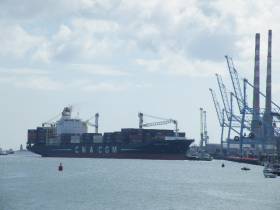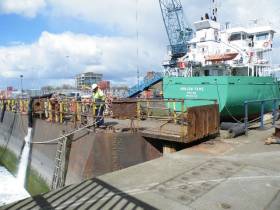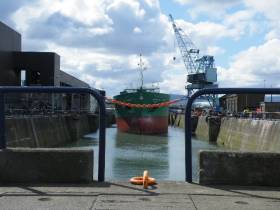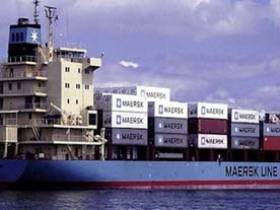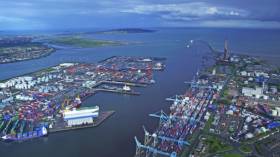Displaying items by tag: Dublin Port
#FuelPipeline - A controversial €20m aviation fuel pipeline proposed by a developer, planned to stretch from Dublin Port to Dublin Airport, must indemnify Dublin City Council against any environmental damage caused by accidents on the line.
The Herald writes that this was one of 33 conditions laid down by An Bord Pleanala in granting planning permission for the 14km project.
Residents living along the route of the proposed line had raised concerns over its safety and possible environmental impact.
The pipeline runs through Dublin City Council and Fingal County Council territory. Both councils granted permission for it to go ahead last year.
While the Fingal decision wasn’t appealed to An Bord Pleanala, appeals were lodged against the decision of Dublin City Council by residents.
For more on the story, click here.
#LargeContainership - One of the largest ever containerships in recent years docked in Dublin Port on the same day of the longest cruiseship to call to the capital, writes Jehan Ashmore.
Afloat.ie has in recent weeks been monitoring CMA CGM Shipping’s containership Nicolas Delmas, with a capacity of 2,207(TEU) twenty foot-long equivalent units, which on Tuesday had discharged and loaded at Peel Ports operated MTL terminal in Ringsend. See, Maersk Line’s new Seago Line route: UK-Ireland-Spain (Algeciras: hubport) for Med/ North African ports.
The call of Nicolas Delmas provided an ideal opportunity to visit Dublin Port where on the opposite side of the port, MSC Cruises giant cruiseship MSC Splendida at 333m long had berthed. This was was the second successive season to the capital by the 4,600 passenger capacity ship.
CMA-CGM's rotation of Nicolas Delmas is operated in a butterfly loop with the Windhoek, 1,577(TEU) on the FAS Irish Sea Feeder service that began in 2003. In fact, Windhoek is due to arrive this evening from Liverpool. Normally the rotation involves the following ports: Antwerp, Southampton, Liverpool, Dublin, Belfast, Greenock, Le Havre and then a return to Antwerp.
The Marsaille based CMA-CGM was formed in 1996 following a merger between Compagnie Maritime d'Affrètement (CMA) and Compagnie Générale Maritime (CGM). The latter partner, CGM had previously run a ‘liner’ side of the business with the famous classic liners 'France' and ‘Normandie’.
In the case of MSC Cruises, they are a parent company of Geneva based Mediterranean Shipping Company (MSC) that continues likewise of rivals CCM-CGM, in the operation of very large containerships fleets on global networks.
At the top of this massive global business is the Maersk Group, which operates the world’s largest container shipping company through subsidiary Maersk Line. Recently the operator launched a new direct Cuba-Cork-continental Europe service.
So it was interesting to witness the contrasting shipping sectors from Dublin's East-Link toll-lift bridge. Also on that day President Higgins in a ceremony unveiled a plaque as the bridge is now named the 'Tom Clarke Bridge'. The bascule bridge completed in 1984 is the final river-crossing between the Liffey and the main port area leading out to the sea.
#1916bridge - President Michael D Higgins unveiled a plaque to ‘Tom Clarke Bridge’ officially now the name to Dublin’s East-Link toll-lift bridge which is the last road crossing over the Liffey before meeting the sea, writes Jehan Ashmore.
The bridge name honours the memory of Tom Clarke, one of the chief organisers of the 1916 Rising and the first signatory of the Proclamation. The unveiling ceremony by the President accompanied by his wife Sabrina, took place on the Ringsend side of the bridge and coincided with the centenary this day 100 years ago of his execution along with Patrick Pearce and Thomas MacDonagh at Kilmainham Jail (Gaol). The State will commemorate all the other executions of the Leaders of the 1916 Rising up to 12 May.
According to Dublin City Council which took control of the bridge last year, there say there are no records of the bridge having been previously named. So for more than 30 years the bridge has been simply known as the ‘East-Link’ or ‘Toll-bridge’ taking traffic, mostly commuting motorists and port-related freight vehicles.
Completed in 1984, the bascule bridge forms a critical part of the capitals road infrastructure and a lifting span (45 metres wide) to permit vessels to pass to and fro between the main port and upriver to the city-centre. The process of raising and closing the span takes 3 minutes.
The last large vessels to transit through the bridge before today’s naming ceremony were a trio of Belgian Navy vessels that departed the capital following a visit over the May bank holiday weekend.
For today's proceedings to take place involving relatives of the 1916 leader, city officials and dignitaries, the bridge was ironically closed to both road and shipping traffic. This caused the most frequent boat user of the bridge, St.Bridget of Dublin Bay Cruises not able to carry out morning cruises. This would of seen the former Aran Islands and Inishbofin ferry berth upriver at Sir John Rogersons Quay.
In terms of the last most frequent Irish flagged commercial shipping to sail past the raised bridge span, that fell to the ‘Guinness’ ships, The Lady Patricia and Miranda Guinness. These purpose-built stout tankers plied the Irish Sea between Dublin and the Mersey and from there onto the Manchester Ship Canal.
The spectacular 333m MSC Splendida, the longest ship ever to visit Dublin Port, returned to Dublin early this morning officially marking the start of Dublin Port’s 2016 cruise season. She is one of 113 cruise calls confirmed for Dublin Port this year, a record number of cruise calls in a year for Dublin Port that will bring over 180,000 visitors to experience the city’s sights and attractions.
Currently the 11th longest cruise ship in the world, the MSC Splendida arrived in Dublin from Greenock, Scotland carrying over 4,600 passengers and crew on board. Her inaugural call made maritime history when she became the longest vessel ever to visit Dublin Port last summer. She boasts a VIP section with 24 hour butler service and features more than a dozen bars and lounges, a spa and Turkish baths, four swimming pools, squash courts and a Formula 1 simulator, all spread over 18 decks. Having arrived from Greenock, Scotland, the MSC Splendida will depart Dublin at 7:45pm for Cork.
The MSC Splendida and other ships greater than 300m in length cannot turn presently within Dublin Port and therefore are brought stern first (reversed) up the Liffey. However, this complicated manoeuvre will no longer be required once the €230m Alexandra Basin Redevelopment (ABR) Project, which will expand capacity in Dublin Port, is complete. Larger ships will then be able to routinely call at the port and turn within the expanded Alexandra Basin West and berth as far upriver as East Link Bridge.
Pat Ward, Head of Corporate Services, Dublin Port Company, said: “We are delighted to welcome the MSC Splendida, the longest ship ever to visit Dublin Port, back to the city to mark the start of our 2016 cruise season. We are shaping up for a record year in cruise tourism, with some 113 cruise calls carrying over 180,000 visitors to the city scheduled for 2016. Highlights this season include the arrival of “Disney Magic” on her maiden call to Ireland in May, as Dublin Port becomes the first Irish port to welcome Disney Cruise Line. Dublin Port will also host the Cruise Europe Conference this year, the first time the conference is to be held in Dublin.”
Final Vessel to Dublin Dry-Dock is Aptly Irish-Flagged Cargoship
#FinalShip – The last ever vessel to use Dublin's dry-dock, cargoship Arklow Fame departed on Wednesday from the unique facility in the capital that officially closes today, writes Jehan Ashmore.
The shiprepairer, maintenance and engineering facility has since 2002 been run by Dublin Graving Docks Ltd under license of the Dublin Port Company. The port company has other plans for the site as part of the €277m ABR project, see report.
Today’s closure marks the end of a chapter in Irish maritime industry that is consigned to historical heritage as well as the loss of 26 jobs staff. The small yet skilled workforce have taken on tasks involving numerous vessels among them containerships, coasters, ro-ro freight ferries, supertrawlers, tugs and timber tallships.
It was fitting that the final vessel to use graving dock no.2 was the Irish flagged Arklow Shipping cargoship and given the Co. Wicklow based company were the firm's largest client.
The 90m Arklow Fame (4,950dwt) is one of the smaller cargoships in the ASL fleet to use the dry-dock as dry bulk-carriers such as the 136m Arklow Marsh (14,490dwt) have occupied the 220m long dockyard completed in 1957. In recent years the ‘M’ class have undergone conversion work at the country's largest dry dock in the capital to increase deadweight tonnage.
Asides routine work carried out on Arklow Fame, the leadship of 10 Spanish built ‘F’ class vessels built a decade ago, also saw work to install a new rudder stock. This involved a manufacturer in Europe to make the replacement part which was transported by truck to be installed at the Dublin facility.
The graving dock could take vessels up to 6.5m draft and had a 24.5m wide entrance accessed by a gate (caisson) see above photo. The watertight retaining structure would be floated in and out of position between pumping in or out water of the dry dock. It should be noted even when a ship was not in dry-dock, work took place at the yard's marine workshop and also off site where required.
Now that the dry dock is closed, ASL will be forced to go elsewhere, noting that Cork Dockyard has a graving dock, measuring 165.5m long and has a narrower entrance of 21.3m. Technically speaking, Arklow Fame with a beam of 14.5m could be accommodated at the country's now largest dry-dock.
So it remains the issues of cost, expertise and strategic location that will determine where shipowners take their business to a graving dock, be it at home or overseas.
In fact during Cork-Swansea Ferries operation and that of the main ferry that ran throughout those years was carried out by the Superferry, however her beam was too wide to use the Cork dry-dock. Instead, the Japanese ferry of more than 14,000 gross tonnes docked at the Dublin facility.
The frequency of ferries using Dublin dry dock however notably declined from around the mid-1990's as the size of newbuilds introduced on the Irish Sea have dramatically increased in tonnage.
This trend in larger ferries undergoing refit overhauls and repairs are mostly carried out in Belfast (Harland & Wolff), Birkenhead (Cammel Laird) and Falmouth (A&P Falmouth).
#DryDockClosing – Its the end of an era as the nation’s largest dry dock is to close with the loss of 26 jobs as Dublin Port Company are to infill the site as part of the €227m Alexandra Basin Redevelopment (ABR) project, writes Jehan Ashmore.
Dublin Graving Docks Ltd has operated Graving Dock No. 2 since 2002 under licence from Dublin Port Company. In recent years the marine engineering business have fought to retain the ship repair, maintenance and conversion facility, however the license expires tomorrow.
The shiprepairer had generated about €2.5m annually. Around 20 vessels have dry-docked each year. Vessels are mostly cargoships/short sea traders, dry bulk-carriers, ro-ro freight ferries, large trawlers, the port company's tugs and in 2014 the tallship Jeanie Johnston. Previous owners of the drydock worked on ferries which are now larger and go elsewhere, not including Cork Dockyard.
For almost 60 years the 220m long dry dock which can handle one large or two smaller vessels at a time has served Irish owned ships and from overseas clients. The final ship to have worked carried out at the 1957 built dry dock was the 90m cargoship Arklow Fame. The 2,998 tonnes vessel called in mid-April and was floated-out with a departure yesterday afternoon.
Dublin Graving Docks had submitted a final observation to the An Bord Pleanála hearing held last year on the ABR which is a Strategic Infrastructure Development that was granted planning permission last summer. The decision leaves the capital port without a strategic ship repair and engineering facility.
The main reason why Dublin Port want to re-use this part of their port estate is to gain a higher financial yield per acre of land through the redevelopment of Alexandra Basin.
The ABR project is to enable much larger and deeper drafted cargoships and the largest cruiseships in the world to berth at a dedicated €30m cruise terminal located closer to the city centre.
Dublin Graving Docks cited they were not opposing the accommodation of giant cruise ships but they were against the reconfiguration and the scale involved in the ABR project.
At approximately 1.4 hecteres the area including the dry dock can handle ships up to 6.5m draft and is accessed by a dock gate 24.5m wide. Under the project this entrance is be blocked with a reconfigured quayside and consequent in-fill of the dry-dock to create additional space. As the port has broken trade figures this has led to critical requirement for additional capacity to cope with demand.
The ABR will be the biggest single infrastructure capital investment development to be undertaken in the past 200 years of the port. Also the project marks phase one of Dublin Port's Masterplan 2012-2040.
Dublin Port Announces 113 Cruise Liner Calls for 2016
Dublin Port Company has announced the launch of its 2016 cruise season as preparations get underway for the return of luxury cruise liner MSC Splendida next week. She is among 113 cruise calls confirmed this season, the largest number of cruise calls in a year for Dublin Port bringing over 180,000 visitors to experience the city’s sights and attractions. Among the 113 calls are four turnaround cruises, which will see passengers travel to Dublin to begin their cruise.
Dublin Port’s cruise business started as early as January with three calls in the first quarter, but the season begins in earnest next week with the arrival of the 333m long MSC Splendida on Tuesday, 3rd May. Currently the 11th longest cruise ship in the world, her inaugural call made maritime history when she became the longest vessel ever to visit Dublin Port last summer. She will return next Tuesday morning carrying over 4,600 passengers and crew on board.
One of this season’s highlights will be the arrival of the 300m long Disney Magic cruise ship when Dublin Port becomes the first Irish port to welcome one of Disney Cruise Line’s signature vessels on Thursday, 26th May. Disney Magic’s maiden call will bring some 3,650 passengers, cast and crew to the capital.
Days later over 200 delegates from leading cruise destinations will converge on Dublin for the Cruise Europe Conference, which will be co-hosted by Dublin Port and Dublin City Council and held in the capital for the first time. The prestigious three day event (31st May – 2nd June 2016) will showcase Dublin to all the major cruise lines and service suppliers of the cruise industry worldwide.
The event comes as Dublin Port plans to market Dublin as a ‘Home Port’ to the cruise industry, having recently established a new cruise tourism development and marketing agency called Cruise Dublin. Set up to promote Dublin as Ireland’s cruise capital to cruise lines internationally, Cruise Dublin works collectively with its members which are drawn from the capital’s leading retail outlets, visitor experiences and tourism bodies, including Fáilte Ireland. As a membership organisation, Cruise Dublin’s remit is to support those businesses in the capital looking to develop their offering in tandem with the future growth of Dublin as a marquee cruise destination.
Pat Ward, Head of Corporate Services, Dublin Port Company, said: “2016 is shaping up to be an exciting year for cruise at Dublin Port with 113 cruise calls and over 180,000 visitors scheduled for the port and the city. We are delighted to welcome the return of MSC Splendida, and one of the highlights this season will be the arrival of Disney Magic on her maiden call in May. For the first time this year, Dublin Port will also host the Cruise Europe Conference.”
“Dublin is rapidly developing a reputation among the international cruise lines as a marquee destination that offers passengers easy access to a vibrant European city. Demand in the market is so strong that Dublin Port is being asked by the cruise lines to accommodate ships much larger than we routinely handle, such as the MSC Splendida. With the ABR Project largely complete in the next four years, Dublin Port will have the enhanced infrastructure and capacity to meet market demand for future years. All the signs from the cruise lines now point to Dublin’s potential to become one of the next leading turnaround capitals for cruise passengers by 2020, especially for the North American market.”
Dublin Port’s current operational limit on ship length is 300m, which means that longer ships such as MSC Splendida cannot currently turn within the Liffey and must, therefore either reverse in or reverse out of Dublin Port. Work has already commenced on the €230m ABR Project which will expand capacity in Dublin Port and will be largely completed in four years. The ABR Project, once complete, will mean that larger ships will be able to routinely call at Dublin Port, turn within the expanded Alexandra Basin West and berth as far upriver as East Link Bridge.
#MaerskFirst – Maersk Group’s first ever direct service to Dublin Port, as previously reported on Afloat, was realised today as the 1,058TEU containership Antwerp berthed this morning, writes Jehan Ashmore.
The new service operated by Maersk subsidiary, Seago Line improves the connections between the UK, Ireland 'feeder-service' to and from the Spanish hub port of Algeciras. This enables Seago customers to have transhipment services to ports in North Africa and the Mediterranean.
Antwerp of 14,093 tonnes had arrived from Liverpool’s Royal Seaforth Dock terminal having discharged and loaded containers on the first leg of the liner service that began at the southern Spanish port.
The 155m long Antwerp is alongside the Peel Ports MTL Terminal located at Dublin’s south bank quays. The UK based Peel Ports Group operates the Port of Liverpool, which also welcomed the first call by the Maersk Group on the Mersey after an absence of more than a decade.
The new service will offer 6 days transit time between Algeciras and Liverpool and 7 days between Algeciras and Dublin.
The new Irish service will supplement an existing Latin American service to Cork. Last month the Northern Dedication of 35,975 tonnes became the largest ever containership to dock at Ringaskiddy Terminal.
The 230m long vessel is operated by sister carrier Maersk Line to provide shippers with an alternative from the current feeder option from Rotterdam in Europe’s northern range.
As for the Antwerp, the vessel was completed in 1999 as the Maersk Antwerp however the Hong Kong flagged vessel was renamed in 2013. The vessel still retains this flag and port of registry of Hong Kong (China).
Busier Than During The Boom As Dublin Port Trade Soars
#TradeSoars -Almost €11m in dividend from Dublin Port Company has been paid to the State as trade and profits surge at the semi-state business.
The dividend for 2015 writes The Irish Independent is almost 24pc more than was paid by Dublin Port in respect of 2014.
Dublin Port Company chief executive Eamonn O'Reilly said that 2016 had started strongly, with the overall level of trade at the facility jumping 6.8pc in the first quarter of the year. Imports were up 6pc in the period, while exports were 7.9pc higher.
The port is now even busier than it was during the boom, with an average of 20 ships a day arriving there during the first three months of 2016.
Trade at the port grew 17.3pc in the three years to the end of 2015.
"Were growth to continue at these rates, Dublin Port's throughput would double by 2026," said Mr O'Reilly, who has been CEO since 2010.
Dublin Port has already embarked on a major €230m project to expand its facilities. That scheme will be completed in four years.
The so-called Alexandra Basin Redevelopment (ABR) will deepen and extend berths, enabling it to handle bigger vessels.
The European Investment Bank has provided €100m in finance for the Alexandra Basin project. It's part of a major masterplan for Dublin Port that is designed to steer expansion to cope with growth up to 2040.
The ABR also includes a scheme for allowing larger cruise ships to visit the capital. They'll also be able to berth closer to the city centre.
To read the full article, click here.
Dublin Port Hosting 2016 ESPO Conference In June
#ESPO2016 - The European Sea Ports Organisation (ESPO) is inviting its members, policy makers and stakeholders to join in the 13th edition of its annual conference, which will be hosted by the Dublin Port Company at The Printworks in Dublin Castle on 2-3 June 2016.
The 2016 ESPO Conference, moderated by broadcaster Claire Byrne, will look into ways to improve the efficiency of maritime transport and ports from different angles.
The first session will focus on the different barriers to the internal market for maritime transport. As maritime policy is at the top of the 2017 European Commission agenda, the ESPO conference aims at preparing the ground for this important year for the maritime and port sector and at feeding further discussions.
Is there a digital agenda for ports? Is there a role for policy? How can ports utilise 'big data' to their benefit? Are we ready to open up the flow of data? How to protect ports against risks of cybercrime? All these questions will be tackled in the second session.
The third session will address the issue of 'game changers' and possible 'game stoppers' when it comes to easing trade. The conference will investigate how TTIP, the trade agreement under negotiation with the US, could possibly benefit ports, on both sides of the Atlantic.
The conference will further zoom into the Chinese 'One Belt, One Road' policy and assess how it might affect European port-hinterland dynamics, as well as the possible impact of a 'Brexit' for UK and neighbouring ports, and how temporary border controls are impacting the European transport and logistics chain.
As usual the conference will close with a policy debate where high-level EU policy makers will present their views on the issues discussed during the conference and enter into a final debate with port authorities.
DG MOVE’s director general Henrik Hololei; Mark Frequin, representing the Dutch Presidency of the Council of Europe; and Pat Cox, former president of the European Parliament and TEN-T coordinator for the Scan-Med Corridor are getting prepared for this session. MEP Knut Fleckenstein will address the conference at the end of day one.
On 3 June, American top economist and influential thinker Jeremy Rifkin will give a keynote address on the theme of 'a Third Industrial Revolution and a Zero Marginal Cost Society'.
The first day's conference sessions will be followed by the Admiral’s Ball, a gala black tie evening celebrating the Lord Mayor of Dublin’s honorary Admiralty of Dublin Port.
The event also launches the Dublin Port Riverfest with a sophisticated evening of fine dining and premium entertainment promised for a guest list of Dublin’s premier business hub and international conference delegates.
Full details of the conference schedule can be found at the ESPO website HERE.



























